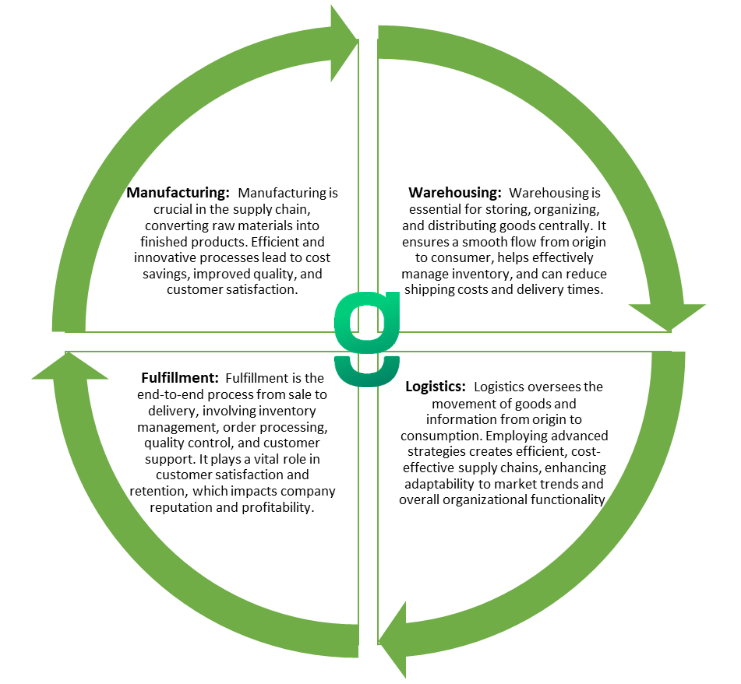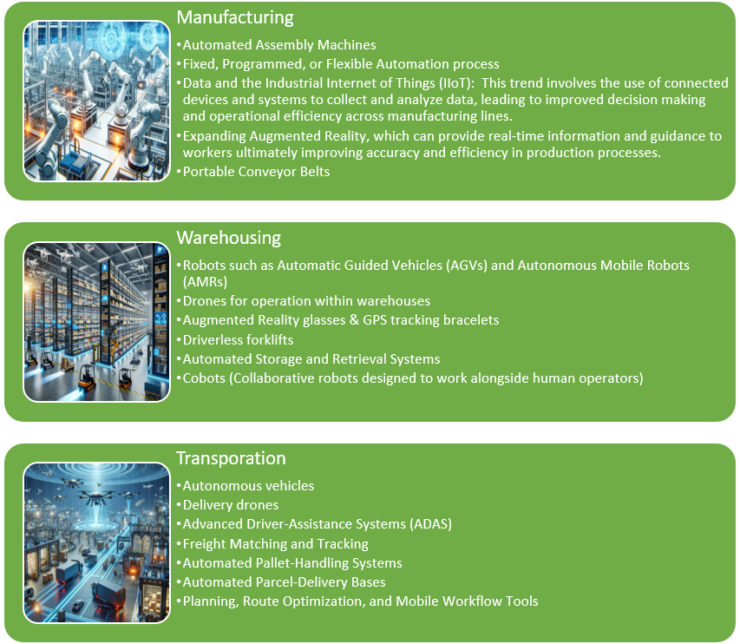Welcome back to our series on trends in supply chains! As we established in our first post, technology is having a dominant and direct impact on supply chains and organizations must strategically adapt in order to stay competitive.
In this post we will dive into four critical pillars (manufacturing, warehousing, logistics, and fulfillment) and critical considerations facing organizations as they assess the future of their supply chains.
Here are the key components shaping each of the four pillars of supply chains:
Examples of critical elements within each pillar are as follows:
1. Manufacturing:
- Digital Transformation: IoT, machine learning, and AI drive efficiency and innovation.
- Reshoring: Bringing manufacturing back for quality control and shorter supply chains.
- Co-Location: Strategically placing facilities for optimized transportation and asset tracking.
- Footprint Optimization: Analyzing and improving production operations for cost and flexibility.
- Make to Order (MTO): Tailoring production to actual demand to minimize waste.
2. Warehousing:
- Expansion and Automation: Meeting increasing demands with automation.
- Central Warehouses: Addressing last-mile delivery challenges for quicker transit times.
- Warehouse Management Systems (WMS): Enhancing efficiency in inventory management.
3. Logistics:
- Transportation Systems: Use of advanced planning systems for the optimization of shipments, fleets, and transportation routes.
- Driver Retention: Strategies to counteract declining interest in driving careers.
- Crowdsourced Delivery: Using local couriers for cost-effective local deliveries.
4. Fulfillment:
- Automation Integration: Streamlining processes from order to receipt.
- Direct-to-Consumer (DTC): Bypassing intermediaries for stronger customer relationships.
- Fulfillment Software: Supporting inventory, order processing, and shipping logistics.
A common theme spanning all four pillars and facing organizations today is automation. Whether in manufacturing, warehousing or transportation, companies have been investing significantly in automation to realize efficiency improvements, lower costs, increased capacity, predictable maintenance and improved operational performance required to meet an evolving and dynamic business environment.
Examples of automation being employed across these pillars include the following:
Optimizing your supply chain in these four areas and factoring in automation involves a strategic, step-by-step approach to identify inefficiencies, evaluate potential benefits, and implement supporting technology solutions effectively.
The following is a recommended approach for organizations planning to optimize their supply chain and tap into automation opportunities:
Phase 1: Assessment and Analysis
– Identify Pain Points: Begin by identifying inefficiencies, bottlenecks, and challenges within the current supply chain operations. Examples could include high operational costs, low inventory turnover, frequent stockouts or overstock situations, and delays in delivery times.
– Evaluate Current Processes: Map out the current supply chain processes to understand the flow of goods, information, and finances. This helps in pinpointing areas that could benefit from optimization.
– Data Collection and Analysis: Collect and analyze data related to supply chain performance, including lead times, inventory levels, supplier performance, and customer satisfaction metrics. This data will provide a baseline for measuring improvement.
– Technology Audit: Assess the current state of technology within the supply chain. Identify existing technologies and their utilization, integration capabilities, and any gaps that automations could fill.
– Market and Technology Research: Research the latest trends in supply chain automation, including software solutions (like ERP, SCM, CRM systems), hardware (like robotics, IoT devices), and emerging technologies (like AI, blockchain). Understand how these could be applied to address identified pain points.
Phase 2: Strategic Planning
– Define Objectives and Priorities: Based on the assessment, clearly define what the organization aims to achieve with optimization, such as reducing costs, increasing speed, improving accuracy, or enhancing customer satisfaction.
– Feasibility Study and ROI Analysis: Conduct a feasibility study for the proposed optimization solutions, including a cost-benefit analysis and an ROI forecast. Consider the financial, operational, and technical viability of implementing these solutions.
– Vendor Selection and Technology Sourcing: Identify potential vendors and technology partners. Evaluate their offerings, support services, and integration capabilities with existing systems. Select vendors that align with the organization’s objectives and budget.
Phase 3: Implementation
– Testing: Before a full rollout, conduct tests of the solutions in select areas of the supply chain. This allows for evaluating the impact on operations, identifying any issues in a controlled environment and will help to evaluate how ready the organization is to adopt the new technologies and processes.
– Training and Change Management: Develop a training program for employees to familiarize them with the new technologies and processes. Implement change management practices to address resistance and ensure a smooth transition.
– Deployment: Proceed with the full deployment of the solution, ensuring it is properly configured and aligned with existing systems and workflows.
– Monitoring and Continuous Improvement: After implementation, continuously monitor the performance of the solution. Collect data to measure improvements and identify areas for further optimization. Be prepared to iterate and make adjustments as necessary.
Phase 4: Review and Scale
– Performance Review: Compare post-implementation performance against the objectives and baseline metrics established in the assessment phase. Evaluate the success of the optimization project in terms of efficiency gains, cost savings, and ROI.
– Scaling and Further Automation: Based on the initial implementation’s success, consider scaling the optimization solution to other areas of the supply chain or implementing additional technologies to further optimize operations.
– Feedback Loop: Establish a feedback loop with all stakeholders, including employees, suppliers, and customers, to gather insights on the impact of the new solution and identify opportunities for continuous improvement.
Throughout this process, it’s crucial to maintain flexibility, as supply chain dynamics can change rapidly due to market conditions, technological advancements, or shifts in consumer demand. By following these steps, organizations can ensure a strategic approach to optimizing their supply chain, leading to enhanced efficiency, reduced costs, and improved competitiveness.
The Gunter Group’s consultants offer industry expertise to guide organizations in assessing and optimizing their supply chains and help businesses maximize the impact of their supply chain operations. Stay tuned for our next post, which will explore tools and practices driving supply chain optimization, including supply collaboration, e-commerce, data analytics, and supply chain flexibility.
PAST ARTICLES IN OUR SUPPLY CHAIN SERIES
– Navigating the Future: 9 Ways Tech and AI are Impacting Supply Chains




